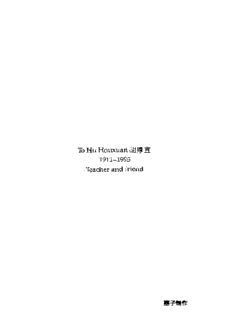
The ancestral landscape: time, space, and community in late Shang China, ca. 1200-1045 B.C. PDF
Preview The ancestral landscape: time, space, and community in late Shang China, ca. 1200-1045 B.C.
ToHuHammaniiJ:l~'§' 1911-1995 Teacher andmend 墨子制作 CHINARESEARCHMONOGRAPH 53 The Ancestral Landscape Time, Space, and Community in Late Shang China (ca. 1200-1045 B.C.) David N. Keightley FIt_ INSTITUTEOFEASTASIANSTUDms a~sU UNIVERSITYOFCALIFORNIA. BERKELEY CENTER FORCHINESESTUDIES 墨子制作 Apublication01the Institute of East AsianStudies, Universityof California,Berkeley. Althoughthelnstitu~ofEastAsianStudiesisresponsiblefortheselectionandacceptance ofmanuscriptsinthisseries,responsibilityfortheopinionsexpressedandlortheaccuracy ofstatementsrestswiththeir authors. Correspondencemay besentto: Ms.JoanneSandstrom,ManagingEditor InstituteofEastASianStudies UniversityofCalifornia Berkeley,California94720-2318 g-mad. [email protected] TheChinaResearch Monographseriesisoneofseveral publicationsseriessponsoredby the InstituteofEastAsian Studiesin conjunctionwithitsconstituentunits. The others include theJapan ResearchMonographseries, the Korea Research Monograph series, and theResearchPapersandPolicyStudiesseries,Allstofrecentpublicationsappearsat thebackofthe book. Libraryof CongressCataloging-in-Publication Data Keightley,David N. The ancestrallandscape:time, space, and communityinlateShangChina,ca. 1200-1045B.C.!David N.Keightley p.em.- (China researchmonograph) Includesbibliographicalreferencesandindex. ISBN 1-55729-071J.-9(pbk.) 1.China-c-History-c-Shangdynasty,1766-1122B.C. 2,China-Civilization-To221 B.C. 3.Oraclebones--China. l.Title. Il.ChinaresearchmonographS 05744+ 931'.01-dc21 00·029598 Copyright©2000byThe Regents ofthe UniversityofCalifornia Library ofCongressCatalogCardNumber 00-029598 Printed inthe UnitedStatesofAmerica. Allrightsres,erved. 墨子制作 Contents Preface vii CitationandTranscriptionConventions xiii 1.Climate 1 2.Agriculture 9 AgriculturalSchedule 10 PestsandDiseases 13 3.Time:Days,Nights,andSuns 17 DayandNight 19 Sun Cult 25 TheShangDay 29 4.TIme:CalendricalStructures 37 TheSixtyNDayCycle 37 TheXun 1UWeek 39 TheLunatic» 43 TheFive·RitualCycle 47 TheNumbered SimERitualCycle 50 5.Space: CenterandPeriphery 55 TheCapitalorCultCenter 56 ±: Th TheFourLands 61 r Fang15AreasandPowers 66 WuIf1Powers 72 GoingsOutandComings In 74 墨子制作 6.Space:Cosmosand Orientation 81 Orientation 82 Cardinal Directions:The Land 86 Cardinal Directions:TheWeather 91 DivinationBonesasWorldMaps 93 7.Community:TheLandandItsInhabitants 97 TheRoyalCommunity 98 OtherCommunities 103 Men,Animals.andLandscape 107 Powerson theLand 113 8.Cosmologiesand Legacies: The"Winds" ofShang 121 Figures 131 Tables 143 KeytotheInscriptionsTranslated, byReferenceNumber 147 IndextotheInscriptionsTranslated 153 BibliographyA:AbbreviationsfortheOracle-Bone CollectionsandReferenceWorksCited 159 BibliographyB:OtherWorksCited 163 Index 201 墨子制作 Preface The Shang dynasty isimportantbecause it was the first Chinese dy nastytohave leftwrittenrecordsandbecause,asthoserecordsreveal, itsculturalchoicesweretoprovideasignificantlegacyforthe Zhouand Handynastiesthatfollowed.' The symbolic orderthattheLate Shang elitescreatedfor themselvesandfor theirworldis,accordingly,ofcon siderable historicalinterest. "Late Shang;" the span oftime covered in thisbook,referstotheperiodfor whichwehaveInscriptions(ca.1200 1045B.C.),from thereignofWuDing:LEtT(thetwenty-firstShangking; see figure 1)tothereignofDiXin:m*(the twenty-ninth]. Thefirsttwochaptersare introductory;theyaddresstheclimateand agriculture of the Anyang :>Z~ region, in the northern Henan pan handle,inthelast fewcenturiesof the secondmillenniumB.C. Idonot claimthat the environmentalbase determined the Late Shang super structure,that"geographyisdestiny,"butIdo urgethatanyattemptto understandthegenesisoftheShangworldorderneedstoconsiderthe influenceofthebiologicalandclimatologicalbuildingblockswithwhich theShangelites,andpeasantrytoo,workedastheyconstructedanIndp ientChinesecosmologyon theNorthChinaplain.' 1.Forthe natureofthe Shanglegacy,whichcanbediscernedinmanyarea,ofthe laterpoliticalculture,see,e.g.,Creel 1937:254;TangYlngya1975;Keightley1978a,1984, 1988.1999b:289-91;Allan 1979;Schwartz1985:16-39;Pankenier1995;see 100chapter8. z.By"cosmology"Imeanatheoryormodelofthephysicaluniverseconsideredas atotalityofphenomenaintimeandspace.ForrecentaccountsofearlyChinesecosmology, seeAllan1991:74-111;Pankenier1995;HwangMing-chorng1996;Wang Ailre,inpress. tlii 墨子制作 viii Preface The next five chapters address Shang notions of time, space, and community.Withregardtotime, muchofmyconcerniswith the ways inwhichtheShangunderstoodand gavestructuretothe passage ofthe hours, days, andmonths. Withregard tospace,Ifollowotherscholars in treatinglandscapesas"constructsoftheimaginationprojectedonto woodand waterand rock"(Schama1995:61).Landscape,inotherwords, asopposedtoterrainortopography,is"aculturalandsocialconstruction, representinganartificialworld asifitweresimplygivenandinevitable" (Mitchell1994:2).Myinterestisin howthe LateShangconstrued and mediatedtheirexternalworld,intheculturetheybuiltuponthatexternal world,andin how that externalworld shapedthatculture. Iam inter ested,moreover,inwhatYi-fuTuan(1'174:4,113)hastermed"tcpophllla," "theaffectivebondbetweenpeopleandplaceor setting" that"couples sentimentwithplace."And Irefer tothe Shanglandscapeasancestral, notonly becauseitwas inhabitedby ancestral(and other)Powers,but alsobecause thelandscape,bothrealandsymbolic,playedagenerative and religiousroleintheculturethattileShangcreatedand transmitted. Asto communities,theyare,asBenedictAnderson (1991:6)has noted, alwaysimagined,and theyare"tobedistinguished,notbytheirfalsity/ genuineness,butby the style in which they are imagined." Iam inter estedinthestyle,asweseeitprimarilyin theirdivinationinscriptions, with which theShangimagined and createdtheir world,bothhuman and natural.Thebookisthusprimarilyastudyinretrospectivecultural anthropologyratherthan,say,astudyofShangpoliticsor economics.' And given the theoretical difficultiesinvolvedinisolating andranking thefactorsthatplayedaroleinthegenesisofasenseoforderandidentity somethree thousandyearsago,mytreatmentfavorsa"thickdescription" thatothers,perhaps,may usetoquestionsomeofmyconclusions. That description, as Ihave indicated, isbased primarily upon the oracle-boneinscriptionsoftheLate Shangdynasty, divinationrecords thatprovideuswith numerousinsightsintotheexperiencesandpriorities oftheShangkings.'Theserecords,theearliestbodyofwritingyetfound in East Asia,wereproducedin the following way.The diviner, some times the king,butoftenanofficerattheShangcourt,presidedover the divinatoryritual.The divinerannouncedthe subject ofthe divination, termed a "charge" (mingci ff(J~) by modern scholars, and applied an 3.Foran introduction tothose aspectsofShang experience,see,e.g.,K. C.Chang 1980:210-59;Keightley1983,1999b:269--a9. 4.The rubbingsofmore than46,000inscribed oracle bones have nowbeenpub lished (for these figures, see Keightley 1990b:40,53).Foran introductionto the Shang oracle-boneinscriptionsandtheir useassources,seeKeightley1978,199tlb,1997,1997b, 1999c. 墨子制作 Preface intenseheatsourceto thehollow thathadbeenpreviouslycarvedinto theback ofa cattle scapula or turtleplastron; having been thinned in thisway,theboneorshellcrackedasaresultoftheheatstress, producing abu- l- shapedcrack(visibleinfigures7and8)onthefrontsurface.The kingtheninterpreted thecrackasaresponse,"lucky" or "unlucky" in varyingdegrees,to thechargethathadbeenproposed.Hepronounced hisforecast. Someor all ofthisinformation, which had probablybeen writtendowninsomeformof"diviner'snotebook"atthetimetheritual was performed,was eventuallycarvedasarecordinto the surfaceofthe boneor shell, togetherwith,onoccasion,a"verification" thatrecorded whathad actually happened.' Most divinationswerenotrecorded so completely,butafulldivinatoryrecordwouldhaveconsistedofapreface (thedate of the divination and the name of the diviner, which I have generallyomittedintheinscriptionsbelow;seep.xiv),acharge(thesub jectmatter,which,inmytranslations,Iplaceindoublequotationmarks), a prognostication (the Icing'sforecast, asin inscriptions (23),[54AB],[58J below),andaverification(theresults,asin [3AJ,[18J,[19]).Anoccasional postjaceprovidedmoreinformationaboutthedateandplaceofdivination andthecircumstancesunderwhichithadbeenperformed(asin[54ABJ, [58],[108]).6Theinscribedboneswereprobablykeptabovegroundfora period of time and were then placed in storage pits in the area of the temple-palacecomplexat XiaotunIJ\Jij" threekilometers northwestof modernAnyang.Theylayintheground,unknowntoscholarsuntilthe startof thetwentiethcentury? Bypresentinga relatively large number of inscriptions, I hope, in some smallway,togivereadersanalmosttactile sense,notonlyofwhat itwastobeaLateShangkingandaLateShangdiviner,butalsoofwhat it is to be a scholar who works with these materials. My reaction to iioguuenhejiEfl~X'El~, therecentlypublishedcompendiumofalmost 42,000oraclebones,isworthquotinghere: Iwould..,stressthesenseofimmediatecontactwiththeinscriptions thatHeji provides.Itisinstructive,evenmoving,forexample,toread through some1,300rubbings fromthe reign ofWuDing(Heji 11750 13048),allconcernedwithrainfall;thecrackingand engravingofthis vastquantityofevent-specificbonesand shellsremindsoneafreshof the effortinvolvedin performingand recording these divinationsso 5,ForafullerintroductiontoShangdivination,seeKeightley1978:6--56.Ontheex Istenceoftheputative"diviners'notebooks,"see Keightley1999c:218-19. 6.Forafurtheraccountofthesedivisionsandterms,see Keightley1978:Z8-30,33 35.40--45.Foran inscriptionwithfour oftheseparismarked,see[51]. 7.Forthediscoveryandearlyscholarlyinvestigationoftheoracle-boneinscriptions, see Lefeuvre1975;WangYuxin1981:3-25;WuHaokunandPanY墨ou子19制85:作1-18. Preface vitaltothewell-beingofthedynasty....Indeed,theexperienceofleaf ingthroughpageafterpageofrubbingsdevoted...toaparticulartopic isquite unlike thatinvolvedinconsultingthestandardized,"sanitized," transcriptions....Heji,ifItdoesnothingelse,encouragesonetorespond tothehistoricalcontextofthebonesinalltheirprofusionand variety.... No oracle-bonescholarcan failtobestimulated tonewthoughtsand reflectionsashe orshe leafsthrough this repositoryofShangwriting, almost overwhelminginitssize.' And by translating, in context, more than a hundred and fiftyof the inscriptionsthat the Shanginscribed on theiroracle-bonesIalso hope tointroducereaderstothewaysinwhichthe earliestwrittendocuments yet foundin Chinamaybestudied. It has been proposed that the oracle-bone inscriptions permit the LateShangtobe characterizedonlyas"protohtstortc,"on thegrounds thatwritingwasnotyet"fullydevelopedandincommonuseforrecord inghistory"(Barnes1993:19;seetooBagley1999:130).TheShangwriting systemwas,infact,welldeveloped,anditisentirelylikelythat theShang keptotherkindsofrecordsthathavenotbeenpreserved.tltis,indeed, the presenceoftheirwritingsystemthatdistinguishestheShangfrom the contemporaryBronzeAgeculturesthatflourishedin China(Bagley 1999:181).Nevertheless,therecordsthatwe haveare certainlylimited innature,andtheinscriptionsthemselvespermitthe reconstructiononly of certain aspects of Late Shang history. Divination was an important Shanginstitution,butthereisnoreasontoassumethatitexpressesthe fullrangeandvariabilityofthe culture(seetoop. 112below).AsIhave earliernoted (Keightley1978:212), the oracle-bone inscriptions tell us "more of the notes of Shang cult than of the music of Shangbelief": thosenotes,however,placed in context, canat least give us asenseof whatthe music wouldhavesoundedlikeandwhatitsstructurewas. With these considerationsin mind,itismy hope thatthe bookwill serveasanintroduction,asaninformedstrollthroughthelandscapeof theboneinscriptions,suggestingsomeoftheconnectionsthatmaybe discernedbeneaththeirsurfacecontentandencouragingfurtherexplo ration. It.offers at least a partial account of the Late Shang elites and theirdailylives,baseduponcontemporarysources. Giventhe challeng ingnatureoftheinscriptions,however,andthe technicaldisagreements that challenge some modern interpretations, a simple "introduction" would,on occasion, proveinadequate andeven misleading. Forsome 8.Keightley1990bA9,withromanization,asinallpassagesquotedbelow,translated into pinyin.Ferliaguwenheji,seebibliographyA,underHeji. 9.Creel1937:171-73;Keightley1969:349-50,1999b:285,287;Bagley1999:182;Boltz 1999:107-8. 墨子制作 Preface issues, indeed, there are no simpleintroductions, and in those cases I havedonemybesttoindicatewherefurtherresearchisneededandthe interpretiveproblemsinvolved. OurunderstandingoftheLate Shang inscriptionsandofthe culturethatproducedthemisstillevolving. Anearlier version of this studywas presented to the Annual Sym posiumin ChineseStudies,"Empire,Nation,andRegion:The Chinese WorldOrderReconsidered;'attheCenterforChineseStudies,Univer sity ofCalifornia at Berkeley,on 3-4 March 1995.Iam grateful for the comments of Judith Boltz, Bruce Brooks, Magnus Plskesjc, Donald Harper, Liu Xueshun, David Pankenier, Michael Puett, Jeffrey Riegel, Edward Shaughnessy, Ken-ichi Takashima, Lotharvon Falkenhausen, and RobinYates,whichhave donemuch to improve itsaccuracy and delineateitsscope withmore precision;andIam particularlygratefulto the faculty and studentmembersofatwo-weekoracle-boneseminarI attendedatthe UniversityofWashingtoninspring1999thatusedafinal versionofthisstudyasitstext:WilliamG.Boltz,MattCarter,ZevHandel, GongHang,StevenHarrell,RobinMcNeal,NewellAnnVanAuken,Suh [enYang,Anne O.Yue,andXiaorongZheng.Ishouldalsoliketothank ImreGalambos forcheckingmyinscriptionreferencesandSeung-joon Leeforhisresearchassistance. Anymistakes,ofcourse,remainmyown. I am grateful, finally,to Joanne Sandstrom for copy-editing the final manuscriptwithclarityandefficiency. 墨子制作
